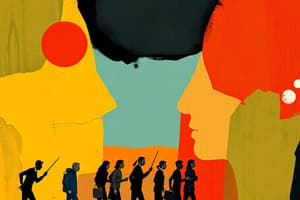Podcast
Questions and Answers
What does Resource Mobilization theory (RMT) focus on?
What does Resource Mobilization theory (RMT) focus on?
The organization of resources, how to pool them, and use them effectively for a social movement. Essentially, it considers the logistics of social mobilization.
What are New Social Movements (NSMs)?
What are New Social Movements (NSMs)?
New Social Movements are often associated with identity-driven causes, such as peace, environmentalism, LGBTQ rights, and human rights. They are typically characterized by their focus on social justice and collective identity.
What is the relationship between deprivation and social movements?
What is the relationship between deprivation and social movements?
Deprivation, particularly relative deprivation, can fuel dissatisfaction and motivate individuals to join social movements. This is when a person feels that they have been unfairly denied the same social rewards or opportunities that other individuals in their social group have.
What is Smelser's structural strain theory?
What is Smelser's structural strain theory?
What are some of the key characteristics of the free-rider problem in social movements?
What are some of the key characteristics of the free-rider problem in social movements?
What does the concept of 'framing' mean in social movements?
What does the concept of 'framing' mean in social movements?
How does the free-rider problem influence the success of social movements?
How does the free-rider problem influence the success of social movements?
What are some ways that social movements can overcome the free-rider problem?
What are some ways that social movements can overcome the free-rider problem?
What are some of the key differences between traditional social movements and New Social Movements (NSMs)?
What are some of the key differences between traditional social movements and New Social Movements (NSMs)?
What are some of the key characteristics of New Social Movements (NSMs)? (Select all that apply)
What are some of the key characteristics of New Social Movements (NSMs)? (Select all that apply)
How do The Raging Grannies exemplify the characteristics of New Social Movements (NSMs)?
How do The Raging Grannies exemplify the characteristics of New Social Movements (NSMs)?
Flashcards
Relative Deprivation
Relative Deprivation
When people feel a significant gap between what they deserve and what they actually get, leading to discontent and potential social movements.
Structural Conduciveness (Smelser's Theory)
Structural Conduciveness (Smelser's Theory)
Describes how social arrangements can either allow or restrict the formation of social movements.
Structural Strain (Smelser's Theory)
Structural Strain (Smelser's Theory)
The tensions, conflicts, deprivations, and inequalities that exist within a society contribute to the formation of social movements.
Growth & Spread of an Explanation (Smelser's Theory)
Growth & Spread of an Explanation (Smelser's Theory)
Signup and view all the flashcards
Precipitating Factors (Smelser's Theory)
Precipitating Factors (Smelser's Theory)
Signup and view all the flashcards
Mobilization for Action (Smelser's Theory)
Mobilization for Action (Smelser's Theory)
Signup and view all the flashcards
Social Control (Smelser's Theory)
Social Control (Smelser's Theory)
Signup and view all the flashcards
Resource Mobilization Theory (RMT)
Resource Mobilization Theory (RMT)
Signup and view all the flashcards
Free-Riders
Free-Riders
Signup and view all the flashcards
Bloc Recruitment
Bloc Recruitment
Signup and view all the flashcards
Framing
Framing
Signup and view all the flashcards
Frame Alignment
Frame Alignment
Signup and view all the flashcards
Transforming Free-Riders
Transforming Free-Riders
Signup and view all the flashcards
Incentives
Incentives
Signup and view all the flashcards
Selective Incentives
Selective Incentives
Signup and view all the flashcards
Professionalization
Professionalization
Signup and view all the flashcards
Fundraising
Fundraising
Signup and view all the flashcards
Bureaucratization
Bureaucratization
Signup and view all the flashcards
New Social Movements (NSMs)
New Social Movements (NSMs)
Signup and view all the flashcards
Identity-Oriented (NSMs)
Identity-Oriented (NSMs)
Signup and view all the flashcards
Strategy-Oriented (RMT)
Strategy-Oriented (RMT)
Signup and view all the flashcards
The Raging Grannies
The Raging Grannies
Signup and view all the flashcards
Strategic Use of 'Little Old Lady' Identity
Strategic Use of 'Little Old Lady' Identity
Signup and view all the flashcards
Black Lives Matter
Black Lives Matter
Signup and view all the flashcards
Study Notes
Week 11B Social Movements
- Resource Mobilization Theory (RMT) focuses on the organization of resources to effectively achieve goals.
- New Social Movements (NSMs) are movements of relatively educated and affluent populations, often focused on identity issues like peace, environmentalism, and LGBTQ+ rights. They are often contrasted with traditional movements, which may be focused more on economic issues.
- Relative deprivation is the difference between what individuals think they deserve and what they actually receive. This perceived gap can motivate social movements.
- Davies' J-curve illustrates the relationship between deprivation and social movements, showing initial satisfaction increases before a gap occurs that can drive people to rebellion.
- Smelser's structural strain theory identifies 6 factors contributing to collective behavior:
- Structural conduciveness (permissiveness of social structures).
- Structural strain (tensions, conflicts, deprivations).
- Growth and spread of an explanation (generalized belief or ideology).
- Precipitating factors (triggers).
- Resource Mobilization Theory (RMT) analyzes how social movements organize resources like people, money, and information to achieve their goals. RMT critiques earlier theories that did not consider external factors important (such as outside influence). RMT's focus shifts from why people want change to how groups can organize for effective change.
- Key aspects of RMT are organization of resources, utilitarian logic (cost-benefit analysis), and recruitment (including attracting existing groups).
- Framing is crucial in RMT. Effective frames resonate with individuals' beliefs and aspirations, promoting participation in the movement.
- The "free-rider" problem addresses the issue of individuals benefiting from a movement's success without participating. Mobilization strategies attempt to address this in order to increase participation.
- Mobilization for action and leadership are critical elements for collective movement. Social control (lack of or insufficient control) can also contribute to movement formation.
New Social Movements (NSMs)
- NSMs emerged in the 1960s and are distinct from earlier, working-class movements.
- NSMs are characterized by social media, universalistic goals (peace, environment, LGBTQ+ rights), and identity-oriented perspectives.
- Case Studies like the Raging Grannies can be used to understand NSM characteristics: identity, strategic use of identity by a group.
Studying That Suits You
Use AI to generate personalized quizzes and flashcards to suit your learning preferences.





